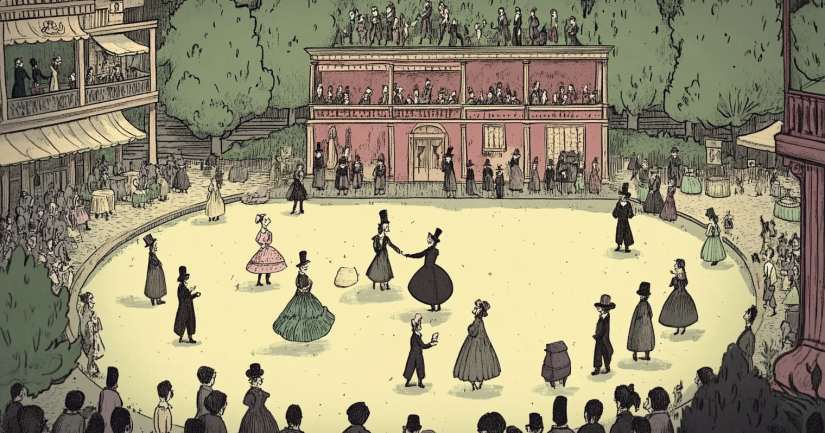
The Much Ado About Nothing Literary Devices Quiz offers an insightful exploration into the intricate tapestry of literary techniques employed by William Shakespeare in his renowned play. By delving into these devices, readers can gain a deeper appreciation for the thematic richness and character complexities that define the narrative.
In “Much Ado About Nothing,” Shakespeare masterfully weaves a variety of literary devices such as dramatic irony, metaphor, and malapropism—to enhance the storytelling and engage the audience. The Much Ado About Nothing Literary Devices Quiz encourages readers to identify and analyze these elements, fostering a comprehensive understanding of how they contribute to the play’s enduring appeal.
Shakespeare’s plays are full of literary devices now see how they influence the sequence of events in Much Ado About Nothing Order Of Events Quiz! If you’re more interested in characters, check out Much Ado About Nothing Character Matching Quiz. And if you think you’ve mastered the entire play, put your skills to the test with Much Ado About Nothing Full Book Quiz!
Furthermore, this quiz prompts readers to consider the broader implications of Shakespeare’s stylistic choices, prompting discussions on how these devices reflect societal norms, character motivations, and the human condition. Engaging with the Much Ado About Nothing Literary Devices Quiz not only tests one’s knowledge but also deepens one’s connection to the timeless themes presented in the play.
Dramatic Irony and Misunderstandings
Dramatic irony plays a pivotal role in “Much Ado About Nothing,” creating tension and humor as the audience is privy to information unknown to the characters. For instance, the audience is aware of Don John’s deceitful schemes long before the other characters, heightening the emotional impact of the ensuing misunderstandings. This device underscores the themes of deception and the fallibility of perception.
Additionally, the use of dramatic irony in the scenes where Beatrice and Benedick are tricked into believing the other is in love with them adds a layer of comedic effect. The audience’s awareness of the ruse enhances the humor and emphasizes the characters’ vulnerabilities and the transformative power of love.
Metaphor and Simile: Expressing Complex Emotions
Shakespeare employs metaphors and similes to convey the characters’ complex emotions and relationships. For example, Benedick compares Beatrice to a “harpy,” illustrating his initial disdain and the sharpness of their exchanges. Such figurative language enriches the text, offering deeper insight into character dynamics and personal growth.
Similarly, Beatrice uses similes to express her skepticism about marriage, likening it to a “Scotch jig”—a fast-paced, fleeting dance. This comparison reflects her views on the transient nature of romantic relationships and societal expectations.
Malapropism and Comic Relief
The character of Dogberry provides comic relief through his frequent malapropisms—misusing words in a way that creates humor. His attempts at sophisticated speech often result in nonsensical statements, such as saying “comprehended” instead of “apprehended.” These linguistic errors not only entertain but also highlight themes of social class and the limitations of language.
Dogberry’s malapropisms serve to contrast the serious themes of honor and deception, reminding the audience of the play’s comedic roots. His character exemplifies how misunderstandings and miscommunication can lead to unintended consequences, reinforcing the play’s exploration of perception versus reality.
Symbolism and Motifs
Shakespeare utilizes symbolism and recurring motifs to reinforce the play’s central themes. The motif of masks and masquerades, for instance, symbolizes the concealment of true intentions and the duality of appearance versus reality. Characters often hide behind literal and figurative masks, leading to both comedic and tragic outcomes.
Another significant symbol is the use of music and dance, representing harmony and discord within relationships. The interplay of these elements underscores the emotional rhythms of the characters’ interactions and the societal expectations governing their behavior.
Conclusion: The Power of Literary Devices
The Much Ado About Nothing Literary Devices Quiz serves as a valuable tool for readers to engage deeply with the play’s intricate use of language and literary techniques. By analyzing these devices, readers can gain a richer understanding of the characters’ motivations, thematic undercurrents, and Shakespeare’s commentary on human nature.
Engaging with the literary devices in “Much Ado About Nothing” not only enhances one’s appreciation of Shakespeare’s craftsmanship but also offers timeless insights into the complexities of love, honor, and societal expectations. The quiz encourages readers to reflect on these elements, fostering a deeper connection to the enduring relevance of the play.
Much Ado About Nothing Quizzes: Love, deception, and wordplay …
Much Ado About Nothing Literary Devices – FAQ
Shakespeare’s Much Ado About Nothing uses dramatic irony, metaphor, and wordplay. Dramatic irony lets the audience know more than the characters, adding excitement. Metaphors express emotions and themes, while witty wordplay brings humor and depth to the dialogue.
Dramatic irony plays a crucial role in Much Ado About Nothing, especially when characters are deceived or misunderstand each other. The audience knows about Don John’s plans and Hero’s innocence before the characters do, creating tension and engagement.
Wordplay defines the banter between Beatrice and Benedick, showcasing their wit and mutual attraction. Their playful language entertains and develops their relationship, revealing their characters and the themes of love and deception.
Metaphors in the play deepen themes like love and deception. Love is compared to battles or dances, highlighting its complexity and strategic nature. These metaphors enhance the audience’s understanding of the characters’ emotions and motives.
Deception is central to the plot, fueling both comedy and conflict. Characters deceive for various reasons, like Don John’s malice or Don Pedro’s matchmaking. This theme illustrates how appearances can be misleading and emphasizes trust and perception.
